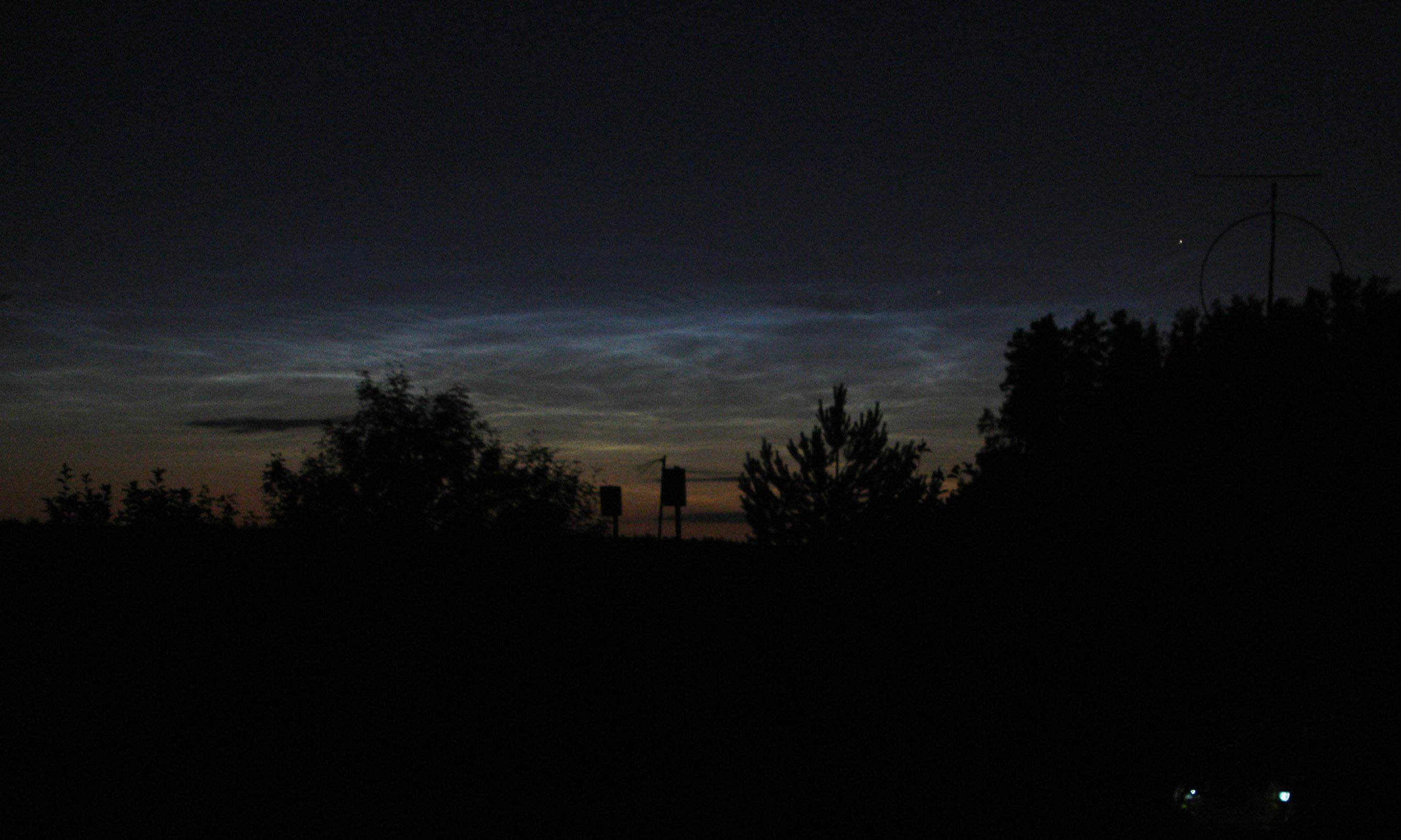Аппаратура граббера установлена в домике, а антенна и МШУ - на деревянной мачте в 20 метрах от дома. Между мачтой и домом проложен коаксиальный кабель.
Первоначально использовалась только рамочная анетенна, впоследствии был дополнительно подключен Минивип, что дало некоторое увеличение отношения сигнал-шум. Рамка была сориентирована для приема в направлении запад-восток. Предполагалось, что сложение Е и Н компонент поля даст улучшение приема и, возможно, кардиоидную диаграмму направленности. ДН была проверена путем вращения антенн на 90 градусов и сравнения полученных спектрограмм. Наблюдать наличие глубокого минимума или какое-то существенное изменение диаграммы не удалось. Поэтому антенна была повернута в исходное положение В-З.
Питание приемника и антенн для уменьшения шумов, приходящих из силовой сети, было решено осуществлять от аккумулятора 12 В 12 А/ч. Ток потребления составил 106 мА, таким образом заряда аккумулятора должно хватать не менее чем на 100 часов работы. Подзарядка аккумулятора осуществляется от небольшой солнечной батареи, либо от самодельного зарядного устройства. В последнем случае на приеме возникает заметный фон 50 Гц, поэтому подзарядка этим способом производится только ограниченное время (примерно полчаса в сутки). Солнечная батарея при освещении прямым солнечным светом дает напряжение 22 В, от рассеянного дневного света около 16-18 В. Однако зарядный ток весьма невелик. По паспорту он должен быть не менее 1 А, но фактически он намного меньше, всего 75 мА. Можно сделать вывод, что такой солнечной батареи недостаточно для полностью автономной работы приемника - аккумулятор хоть медленно, но все же разряжается. Нужно будет хотя бы удвоить площадь батареи.
Компьютер питается от собственного блока питания. Его временное отключение от сети позволяет вовсе устранить нежелательный фон и наводки. Пока приходится мириться с их наличием.
Подключение к интернету осуществляется с помощью USB-модема GSM/GPRS/EDGE/.... В месте установки граббера отсутствует покрытие сетей 3G, подключение не очень устойчивое. Поэтому пришлось модем разместить в выносной пластиковой коробке, подсоединив к компьютеру через 5 метровый USB кабель.
Ниже привожу выдержку из "аппаратного журнала" граббера.
Experiment was begun on July 03, 2014.
The equipment of the grabber is installed in a lodge, and the antenna and LNA - on a wooden mast in 20 meters from the house. Between a mast and the house the coaxial cable is laid.
It was originally used only Loop antenna, the MinWhip that gave some increase in the relation a signal noise was in addition connected subsequently. The Loop was oriented for reception in the direction the West-East. It was supposed that addition E and B component of a field will give improvement of reception and, probably, the cardioid directional pattern. Direction pattern was checked by rotation of antennas on 90 degrees and comparison of the received spectrograms. To observe existence of a deep minimum or any essential change of the chart it wasn't possible. Therefore the antenna was turned in a starting position of E-W.
Power supply of the receiver and antennas for reduction of the noise coming from a power network, was decided to carry out from the accumulator 12 V 12 A/h. Current of consumption made 106 mА, thus the charge of the accumulator has to suffice not less than on 100 hours. Recharge of the accumulator is carried out from the small solar battery, or from the self-made charger. In the latter case on reception there is a noticeable background of 50 Hz therefore recharge by this way is made only limited time (about half an hour per day). The solar battery when lighting by a direct sunlight gives voltage of 22 V, from the scattered daylight about 16-18 V. But charging current is very insignificant. According to the passport it has to be not less than 1 A, but actually it much less, 75mA. It is possible to draw a conclusion that it isn't enough such solar battery for completely autonomous operation of the receiver - the accumulator though slowly, but nevertheless it is discharged. It will be necessary to double the battery area at least.
The computer is powered from own power unit. Its temporary disconnection from a network allows to eliminate at all an undesirable background and aimings. While it is necessary to be reconciled with their existence.
Connection to the Internet is carried out by means of the GSM/GPRS/EDGE USB-modem. In an installation site of the grabber there is no covering of networks 3G, connection not really steady. Therefore it was necessary to place the modem in a portable plastic box, having connected to the computer through 5 meter USB cable.
I give excerpt from "log" below the grabber.
"Погода с 03 июля по 08 июля стояла теплая или даже жаркая, с небольшими облаками, гроз и дождей не было. Небольшой ветерок, чаще с северо-запада. Ночью, в те сутки, когда небо было ясное, наблюдались серебристые облака. 05 июля вечером в перистых облаках наблюдались два ложных солнца справа и слева от Солнца на закате, это были короткие кусочки радуги - редкое явление иризации.
08 июля во второй половине дня с северо-запада приближалась гроза, были видны молнии и слышны отдаленные глухие раскаты, подул холодный ветер, но к нашей позиции так и не приблизилась.
09 июля было тепло и солнечно.
10 июля с юга было видно грозовое облако и слышен далекий гром. К вечеру задул холодный юго-восточный ветер сильными порывами (холодный фронт), принесший с собой резкое похолодание, сплошную облачность; однако грозы и дождя не было.
Утром 11 июля на спектрограмме обнаружил трассу сигнала на 8270.0003 Гц, с 00 часов до примерно 04-05 часов гмт. Сила сигнала постепенно уменьшалась от начала к концу, приближаясь к уровню помех, что косвенно свидетельствует (по мнению Paul Nicholson) о том, что сигнал приходит издалека - в целом повторяет уровень далеких грозовых разрядов. Пока что природа сигнала остается неизвестной.
"Weather stood from July 03 to July 08 warm or even hot, with small clouds; thunder-storms and rains weren't. The small breeze, is more often from the northwest. At night, those days when the sky was clear, silvery clouds were observed. On July 05 in the evening in plumose clouds two mock suns on the right and to the left of the Sun at sunset were observed, it were short slices of a rainbow - an unusual occurrence of an irisation.
On July 08 in the second half of day from the northwest the thunder-storm came nearer, lightnings were visible and the remote deaf peals are audible, the cold wind blew, but to our position didn't come nearer.
On July 09 it was warm and solar.
On July 10 from the South the storm cloud was visible and the far thunder is audible. At the evening cold southeast wind blew strong rushes (the cold front), brought a sharp cold snap, continuous overcast; however the thunder-storm and a rain wasn't.
In the morning on July 11 on the spectrogram I found the signal trace on 8270.003 Hz, from 00 to about 04 or 05 UTC. Signal force gradually decreased from the beginning by the end, coming nearer to level of hindrances that indirectly testifies (according to Paul Nicholson) that the signal comes from far away - as a whole repeats level of far lightning discharges. Meanwhile the nature of a signal remains to the unknown.
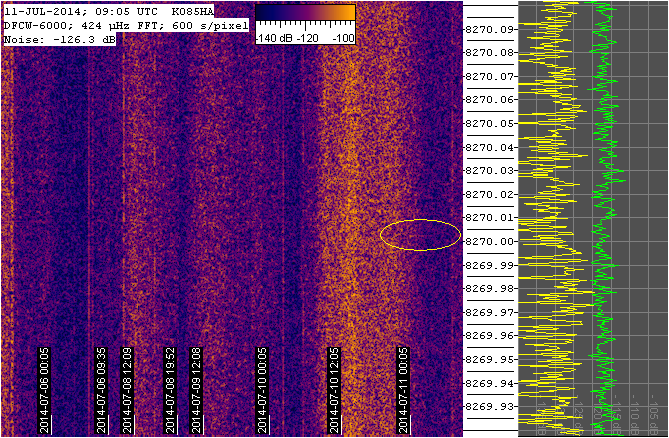
Ночью 11-12 июля с 20 до 22 гмт и далее к утру отмечался интересные селективные замирания на спектрограмме 0-23 кГц, по "полотну" грозовых разрядов четко прослеживалась картина гребней и впадин с шагом около 1 кГц, то есть задержка между лучами порядка 1 мс. Погода теплеет, ветренно с юго-востока, облака тонкие сплошные, с северо-востока виден их край и голубизна. Днем потеплело, небо очистилось, солнечно. Ветер с небольшими порывами с юго-востока.
At night on July 11-12 with 20 to 22 UTC and further by the morning it was noted an interesting selective fading on the spectrogram of 0-23 kHz, on "cloth" of lightning discharges the picture of crests and hollows with a step about 1 kHz, that is a delay between beams about 1 ms was accurately traced. Weather grows warm, is windy from the southeast, a cloud thin continuous, from the northeast their edge and blueness is visible. Became warmer in the afternoon, the sky was cleared, solarly. Wind with small rushes from the southeast.
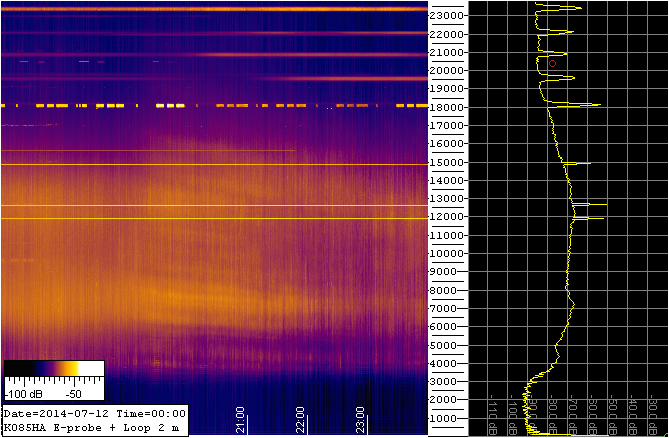
Вечер ночь и утро 12-13 июля - тепло, ветер с востока, облаков нет, солнечно. На ночном скриншоте вновь прослеживается многолучевость, можно выделить как минимум три луча - видны селективные замирания с шагом 1 кГц и 6-7 кГц, то есть задержка между лучами 1 мс и 0.15 мс. Картина имеет медленный дрейф вниз со скоростью примерно 1 кГц за 2-3 часа, а на данной частоте максимум сменяется минимумом и затем максимумом примерно за 1.5-2 часа,что дает величину допплеровского рассеяния 1\3600\1.5=0,18 мГц. Процесс замираний резко возник в 19 гмт и продолжался до 01 гмт.
Evening, night and morning on July 12-13 - heat, a wind from the East, clouds isn't present, solarly. On a night screenshot the selectng is traced again, it is possible to allocate at least three beams - a selective fading with a step of 1 kHz and 6-7 kHz, that is a delay between beams of 1 ms and 0.15 ms is visible. The picture has slow drift down with a speed about 1 kHz in 2-3 hours, and at this frequency the maximum is replaced by a minimum and then a maximum approximately in 1.5-2 hours that gives the size of Doppler dispersion of 1\3600\1.5=0,18 mHz. Process of a fading sharply arose in 19 UTC and proceeded to 01 UTC.
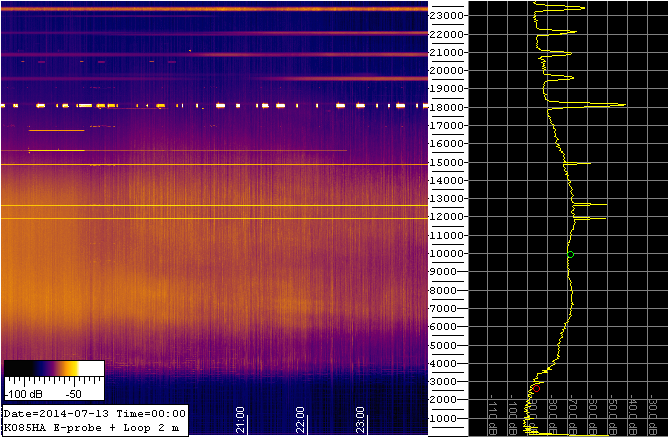
14 июля установилась безветренная жара 32С, небо чистое без облаков. К вечеру появилась тонкая дымка. USB-модем при такой температуре несколько раз отключался. На ночном скриншоте отсутствуют прежние "мелкомасштабные" замирания с шагом 1 кГц, есть более крупные, "малоселективные" по частоте (6-7 кГц) с периодом около 1.5-2 часов, то есть за это время фаза поворачивается на 2 пи.
Механизм возникновения подобных замираний предполагает наличие источника сигнала, достаточно локализованного в пространстве, иначе волны от разных рассредоточенных источников будут замирать по-разному и общая картина будет смазанной, усредненной. Не означает ли это, что в данных случаях источником грозовых разрядов была какая-то локальная зона нрозовой активности (возможно, в экваториальной зоне)? А если замирания не наблюдаются, то тогда грозовых зон несколько?
On July 14 the windless heat +32C, the sky pure without clouds set in. By the evening there was a thin haze. The USB modem at such temperature was several times switched-off. On a night screenshot there is no former "small-scale" fading with a step of 1 kHz, is larger (6-7 kHz) with the period about 1.5-2 hours, that is during this time a phase turn on 2 pi.
The mechanism of emergence of a similar fading assumes existence of a source of the signal which has been rather localized in space, differently waves will fade with the different dispersed sources differently and the overall picture will be greased, average. Whether means it, what in these cases was one local zone of thunderstorms activity (probably, in the equatorial zone)? And if a fading isn't observed, then found a lot storm zones?
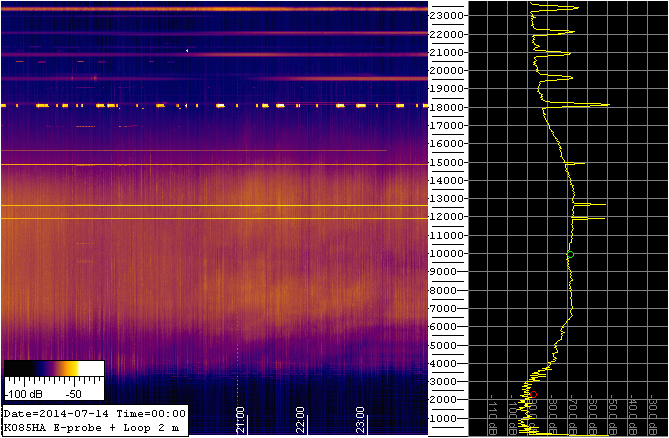
Утро 15 июля - безветренно, легкая дымка, просвечиваемая солнцем. Днем было жарко +32 С...
На скриншоте несколько необычная, хаотичная картина замираний с квазипериодом около 1 часа.
16 июля - последний день работы граббера: мой отпуск подходит к концу, я покидаю домик в деревне. Небо с утра совершенно безоблачно, будет очень жарко. Ночные скриншоты несколько прояснили вчерашнюю картину. На них видно, что вначале с 19:30 UTC имеет место интерференция двух лучей с задержкой порядка 1 мс и большим допплеровским смещением - за 1 час картина смещается вверх на 3 кГц, максимум сменяется минимумом в течение не более 30 минут, что дает Fd=1/1800=0,56 мГц. Затем в 21 UTC картина резко меняется, происходит своего рода "перегиб" или "переключение" и дальше максимумы и минимумы не смещаются по частоте, а значит и допплеровский сдвиг крайне мал.
Morning on July 15 - no wind, the easy haze illuminated by the sun. Was hot +32 C in the afternoon...
On a screenshot a little unusual, chaotic picture of a fading with the quasiperiod about 1 hour.
On July 16 - the last day grabber works: my holiday comes to an end, I leave a lodge in the village. The sky since morning is absolutely cloudless, will be very much hot. Night screenshots cleared a yesterday's picture a little. On them it is visible that in the beginning from 19:30 UTC the interference of two beams with a delay about 1 ms takes place and big Doppler shift - in 1 hour the picture is displaced up on 3 kHz, the maximum is replaced by a minimum within no more than 30 minutes that gives Fd=1/1800=0,56 mHz. Then in 21 UTC picture sharply changes, there is some kind of "excess" or "switching" and maxima and minima are farther aren't displaced on frequency, so and Doppler shift is smallest.
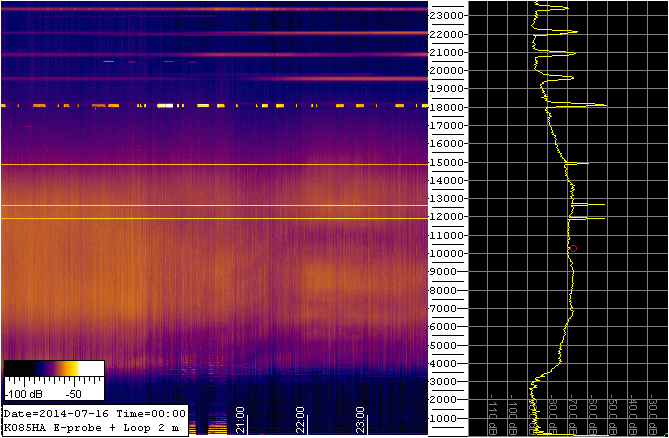
С этого момента появляется еще один луч с задержкой около 0,15-0,2 мс (появляется плавный провал в районе 11 кГц, также без допплеровского смещения. Наконец, с 00:30 UTC вновь появляется плавно нарастающий допплеровский сдвиг между лучами, картина начинает задираться вверх, меняется и задержка между лучами: луч с задержкой 1 мс практически исчезает, остается луч с задержкой около 0,25-0,3 мс. После 02 UTC явление селективного фединга ослабевает и больше не фиксируется.
From this point there is one more beam with a delay about 0,15-0,2 ms (there is a smooth failure around 11 kHz, also without Doppler shift. At last, from 00:30 UTC appears again smoothly accruing Doppler shift between beams, the picture starts being lifted up, the delay between beams changes also: the beam with a delay of 1 ms practically disappears, there is a beam with a delay about 0,25-0,3 ms. After 02 UTC phenomenon of a selective fading weakens and it isn't fixed any more.
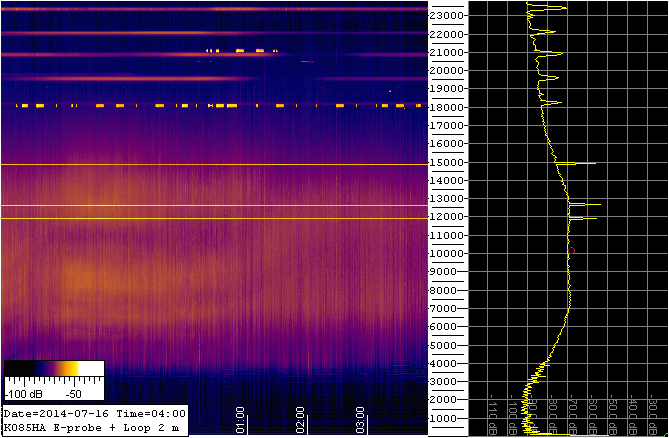
Отмеченные моменты времени соответствуют середине "серой линии" или вечерних сумерек (19:30), когда солнечный свет перестает достигать высот слоя D ионосферы и начинается рекомбинация и уменьшение его электронной плотности. Высота ионосферы увеличивается, возникает допплеровский сдвиг. Начало темного времени суток, то есть истинная ночь (21:00) приносит с собой завершение процесса подъема ионосферы, все успокаивается. В 00:30 мы находимся в середине серой линии, солнечный свет начинает увеличивать электронную концентрацию нижних ионосферных слоев, зона отражения начинает опускаться, возникает допплеровский сдвиг. Наконец в 02:00 уже светло, Солнце поднялось над горизонтом, ионосферные процессы перешли в состояние дня. Интересно, что днем наличие нескольких лучей не фиксируется.
Noted timepoints correspond to the middle of "the gray line" or evening twilight (19:30) when the sunlight ceases to reach heights of a layer D ionosphere and the recombination and reduction of its electronic density begins. Height of an ionosphere increases, there is a Doppler shift. The night-time beginning, that is true night (21:00) brings with itself completion of process of lifting of an ionosphere, everything calms down. At 00:30 we are in the middle of the gray line, the sunlight starts increasing electronic concentration of the bottom ionospheric layers, the zone of reflection starts falling, there is a Doppler shift. At last at 02:00 already light-, the Sun rose over the horizon, ionospheric processes passed into a state of day. It is interesting that in the afternoon existence of several beams isn't fixed.
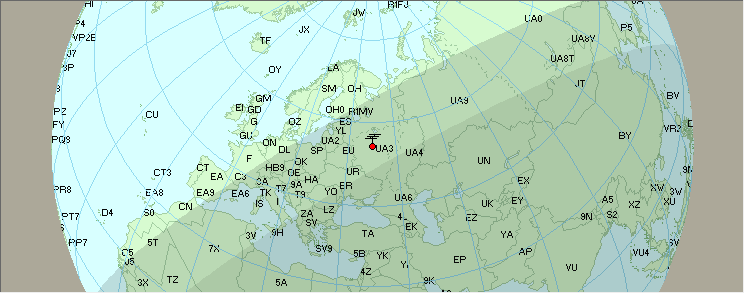
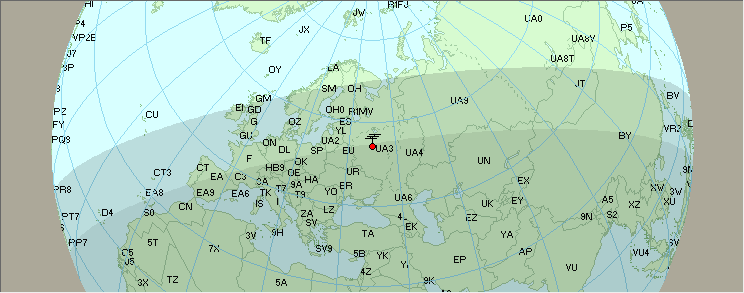
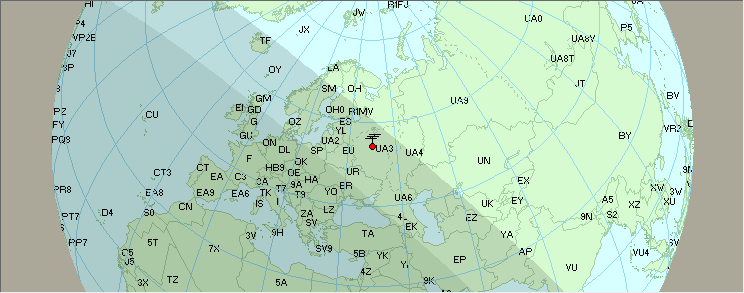
Должен сказать, что наблюдение картины интерференции нескольких лучей в ночное время для меня является новым. Не знаю, наблюдалось ли подобное на других грабберах?
I have to tell that for the first time I see a night interference of several beams in VLF range. It is experience new to me and knowledge. I don't know, whether it was observed similar on other grabbers?
"
Выводы:
1) Выбранное место установки граббера достаточно тихое, отсутствуют ярко выраженные помехи.
2) Предпочтительно аккмуляторное питание граббера.
3) В следующем сезоне применить две скрещенные рамки для осуществления пеленгации источников грозовых разрядов (RDF).
4) Новым для меня явилось открытие многолучевости и замираний на "полотне" грозовых разрядов на спектрограмме.
5) Зафиксирован гармонический сигнал на частоте 8270.003 Гц невыясненной природы, вероятно, пришедший издалека.
Conclusions:
1) The chosen installation site of the grabber rather silent, there are no pronounced hindrances.
2) Power supply of the grabber from accumulators and solar batteries is preferable.
3) In the next season it will be necessary to apply two crossed loops to implementation of direction finding of sources of lightning discharges (RDF).
4) To me observation of a fading on the spectrogram of lightning discharges was new.
5) The signal trace at a frequency of 8270.003 Hz of the obscure nature probably the comer from far away was captured.
Update 24-dec-2014: SAQ recieved with RST 599 +30 dB
Full transmission (4,36 Mb)
and screenshot
73 de RN3AUS/Alex
